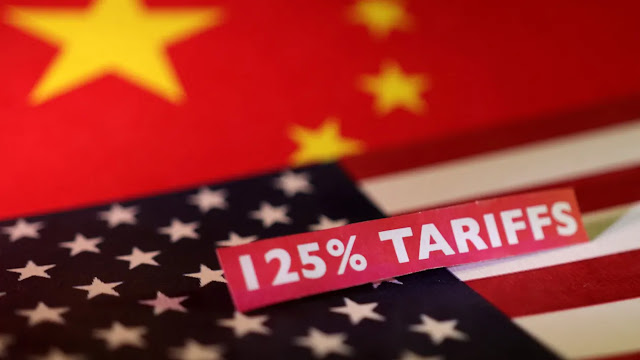Beijing hits back in response to the Trump administration’s move to raise tariffs on Chinese goods to 145%, saying it would fight to the end.
The Washington Post
By Andrew Jeong and Katrina Northrop
Beijing punched back with its own tariffs of 125 percent on all U.S. goods on Friday in response to President Donald Trump’s tariff increases, sharply escalating the spiraling trade tensions between the U.S. and China. The response underscored China’s decision to stand firm in the face of pressure from Washington, and deepened the showdown between the world’s two largest economies.
“If the U.S. insists on substantively damaging China’s interests, China will firmly retaliate and fight to the end,” China’s State Council said in a statement.
The move came after Trump increased the levies on Chinese goods to 145 percent on Wednesday, while also announcing the tariffs he had previously imposed on more than six dozen other countries would be fixed at 10 percent during a 90-day pause.
The State Council, in its statement, also derided Trump’s move to continue ratcheting up the levies, saying that they “no longer have any economic significance” because the current levels make U.S. exports to China not financially viable. The new Chinese tariffs are effective Saturday.
On Thursday, Beijing also moved to limit the number of U.S. films allowed into the Chinese market.
Before Beijing’s announcement, the tariff turmoil led markets in Asia to tumble Friday.
Japan’s Nikkei 225 and Topix indexes dropped by 5 percent, before trimming their losses to under 3 percent in afternoon trading. South Korea’s Kospi and Australia’s ASX 200 fell by less than 1 percent, while Taiwan’s bourse kicked off the day with a fall of under 1 percent before logging a 2.5 percent gain. Hong Kong’s Hang Seng Index and China’s Shanghai composite index netted losses of under 1 percent in early trading but reversed them in the afternoon.
The market swings came after falls in the U.S. markets. The S&P 500 fell 3.46 percent, and the tech-heavy Nasdaq composite index lost 4.26 percent on Thursday, while the more narrow Dow Jones Industrial Average slid 2.54 percent. Those moves followed news that the White House had said import duties on Chinese exports to the U.S. would be 145 percent.
The declines came just a day after a rally, when the same markets posted big gains and the S&P 500 had its biggest one-day jump since 2008.
Representatives from more than a dozen countries are seeking to negotiate new trade deals with the White House, The Washington Post reported. Trump will negotiate with some countries directly, while other senior administration officials will split up the rest, based in part on who has the best existing relationship with the representatives of a particular country.
Export-dependent Asian countries have been seeking to quickly address Trump’s tariffs.
Japanese Prime Minister Shigeru Ishiba said Friday that Tokyo would try to address U.S. tariffs affecting the auto and steel industries, while South Korean Finance Minister Choi Sang-mok said the government would provide $6.2 billion in assistance to businesses exporting to the U.S.
Taiwanese President Lai Ching-te wrote in an op-ed this week that Taipei would seek to buy additional U.S. arms and expand investments in the U.S.
Washington and Beijing are now locked in an escalating tit-for-tat trade war that is increasing market volatility and likely to hurt consumers in both countries.
On average, a U.S. household will face a loss of $4,700 at last year’s price levels when accounting for all of Trump’s tariffs, which will also cut U.S. gross domestic product by around 1.1 percent, according to an April 10 estimate from the Budget Lab at Yale University. And while a defiant China has repeatedly vowed that it will not cave to Trump’s tariffs, Beijing is struggling with a property market slump, high youth unemployment and weak domestic spending.



No comments:
Post a Comment